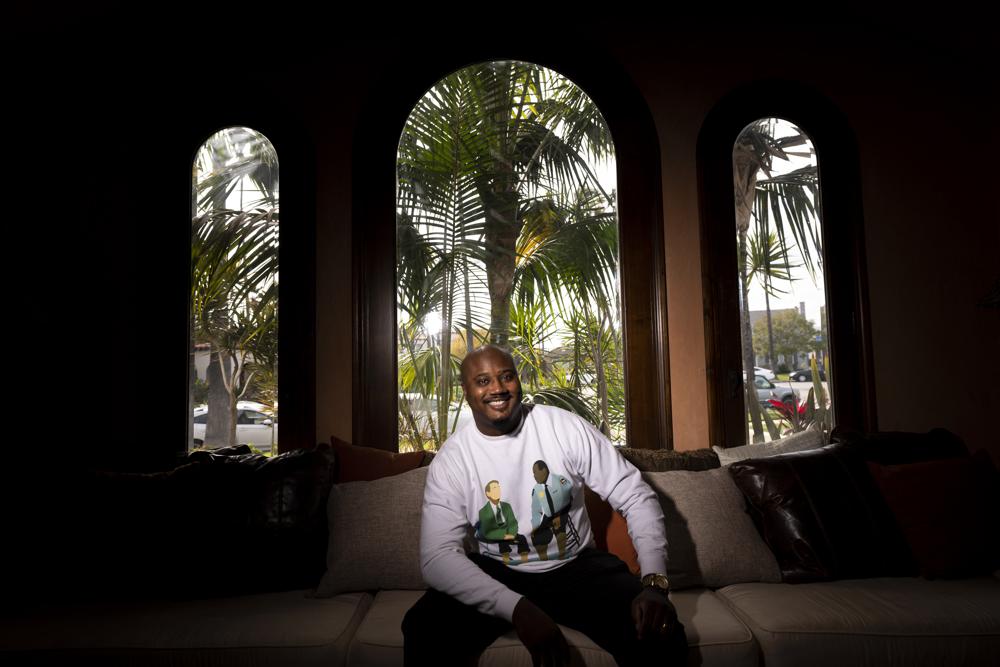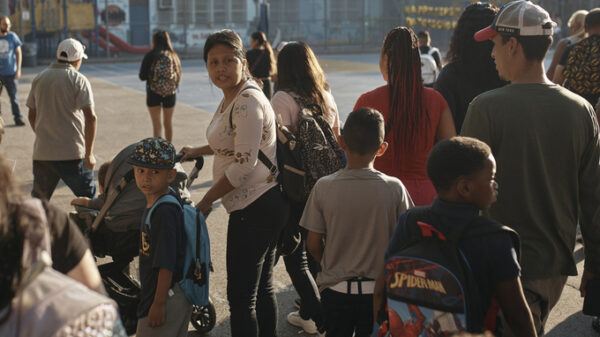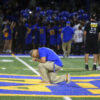Brandon Brown poses for photos in Los Angeles, Thursday, March 25, 2021. Brown, a former history teacher and assistant high school principal, is now a Billboard-charting educational rapper who performs around the U.S. He founded School Yard Rap, a California-based company that produces music about historical Black, Latino and Indigenous people often not found in traditional textbooks. (AP Photo/Jae C. Hong)
PHOENIX (AP) — Sit down. Be quiet. Follow instructions.
Brandon Brown followed these rules when he started teaching, seeking order in a classroom setting he was all too familiar with growing up. But he quickly realized that was not working for his students and that they were just regurgitating what he told them. So, he decided to get creative.
Brown, a former history teacher and assistant elementary school principal, is now a Billboard-charting educational rapper who performs around the U.S. He founded School Yard Rap, a California-based company that produces music about historical Black, Latino and Indigenous people often not found in traditional textbooks.
“By state standards, my students had to learn about old white slave owners, but they were young Black kids, and it wasn’t connecting,” said Brown, who released his latest album under his stage name, “Griot B.” “This education system is whitewashed completely. But doing what I do, I’m able to introduce and refocus on people of color so students are getting the full range of American history.”
Teachers have long sought ways to deliver a complete version of U.S. history that engages their students and includes contributions by people of color. They have been reenergized after the 2020 police killing of George Floyd to take different approaches in the classroom that would challenge an education system many believe doesn’t allow for critical thinking and forces a narrow worldview.
They also are facing increased pressure from politicians and other critics who take issue with how schools address diversity and representation, including a recent push to ban critical race theory, an academic framework centered on the idea that racism is systemic in the nation’s institutions. While there is little evidence that critical race theory itself is being taught to K-12 public school students, some ideas central to it, such as lingering consequences of slavery, have been.
Teaching has evolved significantly in the past decade to focus more on critical thinking as opposed to rote memorization, said Anton Schulzki, a history teacher in Colorado Springs and the president of the National Council for the Social Studies. Some of the shift started with the implementation of Common Core, which placed an emphasis on teaching students how to find and analyze sources. Instead of just learning dates and names, students learn how to form arguments, to find factual evidence to support their claims and to challenge and defend different viewpoints.
“We’re trying to get students into this notion of asking questions and being able to take what they are able to do and put into practice that whole inquiry method,” Schulzki said. “We want them to be good citizens and the way you become a good citizen is you ask questions, and then you try to do something about it.”
Students also need to learn more about the resilience and accomplishments of marginalized communities, said John Deville, who has been an educator in Macon County in North Carolina for nearly three decades.
Teachers need to show people of all backgrounds as more than victims and as individuals with agency and power, he said.
In his classroom, Deville, who is white, avoids framing individuals as either “villains or plaster heroes,” and he incorporates more than just European and white perspectives on historical events. In a unit on Christopher Columbus, Deville said he spends time creating a vision of the Western Hemisphere prior to European contact and does not diminish the violent ways Native Americans were treated.
There is no standardized curriculum across the U.S.; those decisions are made at the local level. As a result, parents, teachers, politicians, and other critics can voice concerns over what some consider a free-for-all of perspectives allowed in the classroom.
Morgan Dick, a spokesperson for the Arizona Department of Education, said civics education, which prepares students to become well-informed, participating members of society, is important because it allows students to engage in “rigorous debate and civil discourse in order to develop their own opinions and learn to respect the perspectives of others.”
She also said some topics could at-times force people out of their comfort zone.
Last month, Republicans in the Arizona House approved a measure that would ask voters to amend the state constitution to ban the teaching of “critical race theory” in schools and bar any preferential treatment based on race. The state Supreme Court struck that law down because it was unconstitutionally included in the budget. In the end, the House passed a resolution, which is not enforceable.
For many teachers, presenting students with different perspectives is the most important part of the job.
“Every kid in America knows 1492 Columbus sailed the ocean blue and they know the three ships, and that’s great,” said Katie Eddings, a middle school social studies teacher in North Carolina’s Lee County. “But do you know what his motivation was during that time period?”
Eddings, whose mother is Lumbee, shows her students excerpts from Columbus’ diary and pushes them to discuss what forces might have shaped the voyages, the achievements that resulted, and the harm caused.
“I want you to ask questions,” she said. “I want you to be curious about why this happened and why that happened. What was the cause and effect, and is there lasting impact now? What happened then? Is there an impact to us now? Are we better off? I just want them to be thinkers.”
Some students may not know the benefit this type of shift in education will have on them until later in life.
It is easy to ask someone to read a book, but you can’t force that person to connect with it, said Kendall Antoine, one of Brown’s former students who challenged Brown to create his first educational rap in 2012.
Antoine, who graduated last year from Morehouse College, a historically Black college, said he still learned what was assigned, but Brown presented it in a more engaging way. He added that he still remembers some of the raps from nearly a decade ago.
“It is amazing what Mr. Brown is doing. Something that started off as a passion for music and history, turned into how he could relate to kids to better their education,” Antoine said.
Ma reported from Charlotte, North Carolina. Mumphrey and Ma are members of the AP’s Race and Ethnicity team.
Copyright 2021 Associated Press. All rights reserved.






























You must be logged in to post a comment Login